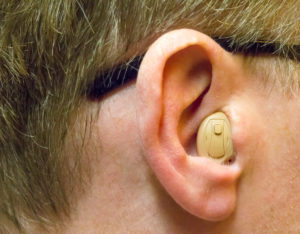
these are the five main types of hearing aids that you can find as your best options to discuss with your audiologist.
Getting a hearing aid can be a big transition, whether you are wearing one for the first time or looking to upgrade from your old one. Today, there are some tested-and-true designs of hearing aids that can fit any lifestyle. Like many forms of technology, the category of hearing aids is ever-expanding. But these are the five main types of hearing aids that you can find as your best options to discuss with your audiologist.
Behind-the-Ear
First, Behind-the-Ear hearing aids have been a standard for years. In a Behind-the-Ear hearing aid, the microphone and speaker are housed in a case that sits against the back of the ear, and a piece of acoustic tubing delivers the sound into the ear canal. They come in a range of sizes and can be the easiest to adjust the volume and programming.
In-the-Canal
The In-the-Canal is a popular choice for custom-fit hearing aids because of its comfort and convenience. Like the name suggests, In-the-Canal hearing aids fit completely in the ear canal. They are a good choice if you wear glasses because they won’t get in the way.
In-the-Ear
Another common type of hearing aid, In-the-Ear hearing aids are known for being easy to put in and remove. The design of an In-the-Ear hearing aid includes a piece that sits in the ear canal connected to an outer part that sits in the ear itself. In-the-Ear hearing aids come in a variety of sizes and colors, which also helps to make them a popular choice.
Receiver-in-the-Canal
Although In-the-Ear hearing aids are popular, many people would consider Receiver-in-the-Canal hearing aids to be remarkable in their own right. The design of the Receiver-in-the-Canal hearing aid houses the battery, microphone, amplifier, and processor all in a behind-the-ear case, while the receiver sits in the ear canal and brings the sound through a small speaker. It is a very common and reliable choice as long as you don’t have any concerns about the behind-the-ear components getting in the way.
Invisible-in-the-Canal
Lastly, the Invisible-in-the-Canal hearing aid is virtually invisible when worn because of how deep it sits in the ear canal. Not only does this design work to look discreet, but it can offer better sound quality by reducing wind noise. Also, it does not need to be adjusted manually. A good variation is the Completely-in-the-Canal hearing aid, which doesn’t sit quite as deeply and can come with an external switch for making adjustments as needed.
Contact Bay Area Audiology Today for Your Hearing Evaluation
Ready to do something about your hearing loss? Our Doctor of Audiology, Dr. Trisha A. Bents Muth, is exceptionally experienced in the art of audiology, and provides the absolute best solutions. Bay Area Audiology has been working to give patients a comfortable environment, with thorough evaluations. We are independently owned, and unbiased when it comes to finding you the care you need.
You can always come into the office, or contact us in advance to set up an appointment. We also provide updates on our social media websites. You can check out our Facebook,Twitter, LinkedIn, and Pinterest to keep up with Bay Area Audiology.
Don’t hesitate–we can help.
